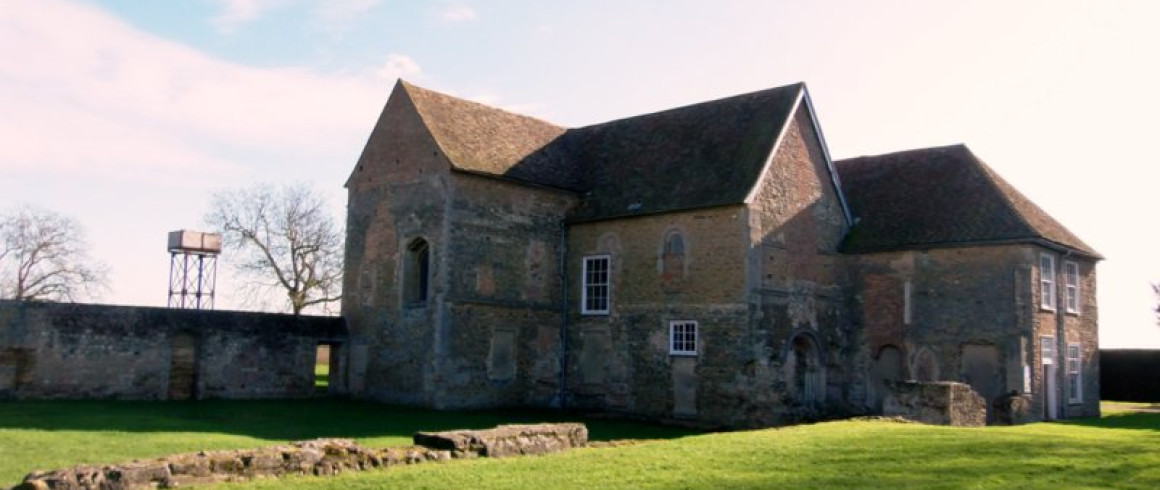The Resting Place of the Foundress
Following on from their report about the birthplace of Pembroke’s Foundress, Marie de St Pol, Kit Smart and alumnus Barrie Cross (1956) have been investigating the site of her burial at Denny Abbey, near Waterbeach.
Denny Abbey was founded by Benedictine monks in 1159 and subsequently occupied by the Knights Templar. In the fourteenth century the Abbey was acquired by Marie de St Pol, the widowed Countess of Pembroke, who had recently founded Pembroke College. She installed a community of Franciscan nuns, known as the Poor Clares, at Denny. The nuns had originally lived at a nunnery at Waterbeach, but the site there was low-lying and prone to flooding. Marie was already associated with the Waterbeach nunnery, and in 1339 she gained permission to move the nuns to Denny. The nuns led an enclosed life, communicating with the outside world only through a ‘dole gate’ (a wooden door with a small hatch through which alms could be doled out to the poor).
The building had to be enlarged to accommodate the nuns, whose numbers ranged from twenty-five to around forty or more. Marie arranged for the east end of the old Benedictine church to be taken down, and the church was extended into what is now the Abbey’s garden. Some of the extension’s foundations are still visible in the grass.
[caption id="attachment_24001" align="alignright" width="300"] Marie's room[/caption]
Marie's room[/caption]
Marie converted the church’s original South Transept into a home for herself, with a spiral staircase bypassing her bedroom to allow the nuns to get from the ground floor to the second floor. Her room would have had a low ceiling and still contains the remnants of a fireplace in the west wall. There may also have been a south-facing window, now obscured by the chimney stack installed in the 16th century, when the Abbey was converted into a Tudor farmhouse. Excavations in the privy adjoining Marie’s room revealed fig and grape seeds, which suggest that Marie enjoyed a more varied and luxurious diet than the nuns living through the wall.
When Marie died, in 1377, she was reputedly buried in front of the high altar in the nuns’ church. The site has yet to be excavated, but if this rumour is true it would locate Marie’s resting place in what is now the garden behind the Abbey’s east wall. The photo below shows the area of grass where the 14th-century altar was probably located. Some of the stonework from the nuns’ church is also visible and gives an idea of how tall the church must have been: the archway is an original part of the nuns’ church, and the pillar to the right is one of two original pillars from the 14th century (the other is now in two parts and currently serves as gateposts at the entrance to Denny Abbey).
[caption id="attachment_24003" align="alignleft" width="300"] The Abbey's east wall[/caption]
The Abbey's east wall[/caption]
Denny Abbey fell victim to the Dissolution of the Monasteries in the 16th century. Commissioners arrived in 1535 to survey the Abbey and reported to Henry VII their encounter with ‘half a dozen nuns who, with tears in their eyes, begged to be dismissed’. The Abbess, Elizabeth Throckmorton, held onto the Abbey until 1539, when she was finally forced to retire to her family home in Warwickshire, taking a few of the nuns with her. The Abbey was sold to Edward Elrington, a property speculator. It was probably Marie’s conversion of part of the Abbey to a private home which saved it from destruction: with the insertion of a chimney, the building was easy to adapt into a functional farmhouse.
[caption id="attachment_24002" align="alignright" width="225"] The nuns' guest hall on the first floor[/caption]
The nuns' guest hall on the first floor[/caption]
The land around the Abbey was farmed for the next few centuries. Pembroke College bought the property from its last resident owners in 1929 and handed the farmhouse over to the care of the Ministry of Works, and later English Heritage. The Farmland Museum was opened in 1997 and is now a joint visitor attraction, telling the story of Cambridgeshire’s farming history alongside the history of the Abbey. Perhaps archaeological work in the future will reveal more about Marie de St Pol’s time at Denny and the true location of her burial site.
Pembroke Portraits
The portrait of Marie de St Pol was the first and, until recently, only portrait of a woman to hang in the Hall in College. She was joined last year by temporary portraits of female Fellows, to celebrate the 30-year anniversary of women’s admissions to Pembroke. The College recently commissioned a portrait of Emma Johnson (1985), Pembroke’s first female Honorary Fellow, which was unveiled last week and will soon be joining Marie in the Hall.

